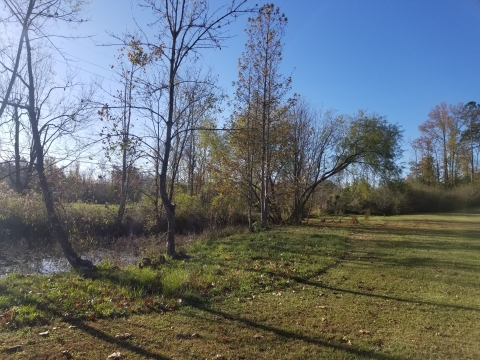Scattered among the sidewalks, roadways, and buildings of Alabama’s largest city are beautiful reminders of the region’s unique geological history. Crystal-clear, perpetually cold water that originates in the untouched caverns below Birmingham supports pockets of wild aquatic vegetation. Five of these urban oases contain the only known populations of the endangered watercress darter (Etheostoma nuchale). The colorful, tiny fish are seldom seen, usually hidden by vegetation.
The urban surroundings carry risks and challenges for management of the species. Some of the threats include: runoff from parking lots and roads; excessive sediment; invasive plants preventing sunlight from reaching the vegetation; barriers to fish passage fish passage
Fish passage is the ability of fish or other aquatic species to move freely throughout their life to find food, reproduce, and complete their natural migration cycles. Millions of barriers to fish passage across the country are fragmenting habitat and leading to species declines. The U.S. Fish and Wildlife Service's National Fish Passage Program is working to reconnect watersheds to benefit both wildlife and people.
Learn more about fish passage ; and beavers.
There are benefits, too, from working in an urban environment, including partnerships with diverse groups that typically have little exposure to careers in the natural resource field. Partners for Fish and Wildlife and the Alabama Rivers and Streams Network, throughout the three-year project, are working with local community groups and students to conserve the watercress darter. Interns and volunteers meet quarterly with the U.S. Fish and Wildlife Service, conservation nonprofits, landowners and others to mitigate threats to watercress habitats.
The Glenn Springs community, below Birmingham in Bessemer, serves as an example of the cooperative partnership. A landowner sought help to protect the aquatic vegetation. An infestation of Chinese privet blocked sunlight from reaching the vegetation. Volunteers from the neighborhood association that owns the site, students from the University of Alabama at Birmingham, and the retailer REI spent two days mechanically clearing the privet, opening up the canopy, and improving the habitat.
By project’s end, the five sites will be vastly improved. It’s budgeted at $247,000 with the Service covering three-fourths of the amount. Promotional videos, educational signage, and quarterly Endangered Species Tours will tell the story of habitat restoration to thousands of people. And, hopefully, the project will influence the next generation of conservationists.




